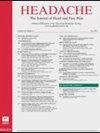Remote electrical neuromodulation to treat children and adolescents with migraine in the emergency department: A randomized double‐dummy pilot trial
IF 5.4
2区 医学
Q1 CLINICAL NEUROLOGY
引用次数: 0
Abstract
ObjectiveUsing a double‐dummy pilot randomized controlled trial design, we aimed to determine the feasibility and acceptability of comparing remote electrical neuromodulation (REN) to typical care intravenous pharmacologic interventions for the treatment of children and adolescents visiting the emergency department (ED) with migraine, and to compare parallel‐group versus crossover trial designs.BackgroundThere are limited data to guide the management of migraine in the ED. Children and adolescents are interested in neuromodulation, and specifically REN, for treatment in this setting, but there are no existing data on this approach.MethodsWe employed a double‐dummy, double‐blind, pilot randomized controlled trial that tested two designs in two phases: a parallel‐group design and a crossover design (ClinicalTrials.gov identifier: NCT05102591). The intervention arms consisted of: (i) active REN stimulation with matched normal saline placebo intravenously, and (ii) matched sham REN stimulation, intravenous metoclopramide (0.15 mg/kg, maximum 10 mg), and intravenous ketorolac (0.5 mg/kg, maximum 30 mg). Youth aged 8.0–<18.0 years visiting a Canadian tertiary care pediatric ED with migraine attacks as per criteria B–E of the International Classification of Headache Disorders third edition were eligible. Primary outcomes were focused on trial feasibility and acceptability, and preliminary efficacy and safety data were also collected.ResultsA total of 34% (22/65) of those who screened eligible were enrolled. Three participants (14%) withdrew prior to receiving any study interventions. In all, 10 participants were allocated to typical care, and nine to REN. All treated participants (19/19) completed all assessments. Recruitment was higher during the parallel‐group phase: 1.1 participants/month versus 0.6 participants/month, and 36% (17/47) versus 28% (five of 18) of screened eligible were enrolled in the parallel‐group and crossover phases, respectively. Participants reported positive impressions of REN use in the ED, e.g., higher mean (standard deviation [SD]) levels of interest in using REN only at 3.7 (1.0) versus 2.8 (1.0) in using intravenous interventions only for a future ED visit. Participants and clinical staff reported overall positive impressions regarding the study protocol. Employing an 11‐point pain numerical rating scale, the mean (SD) reduction in pain severity score was 2.1 (1.3) and 2.9 (2.9) from baseline to 1 h, and 2.4 (1.6) and 4.0 (3.5) from baseline to 2 h for REN and intravenous interventions, respectively. One participant in the typical care group and none in the REN group experienced adverse events.ConclusionWe demonstrated the feasibility and acceptability of our trial protocol and of using REN to treat youth presenting to the ED with migraine. The parallel‐group design generated a higher recruitment rate than the crossover design. Our preliminary efficacy and safety data suggest that REN could be non‐inferior to typical care, but we were not powered for these outcomes. Further research on REN's use in the ED setting is warranted.在急诊科治疗儿童和青少年偏头痛的远程电神经调控:随机双盲试验
背景用于指导急诊室偏头痛治疗的数据非常有限,儿童和青少年对神经调控,特别是远程神经调控(REN)治疗偏头痛很感兴趣,但目前还没有这方面的数据。儿童和青少年对神经调节,特别是 REN,在这种情况下的治疗很感兴趣,但目前还没有关于这种方法的数据。方法我们采用了一项双盲、双假、试验性随机对照试验,分两个阶段测试了两种设计:平行组设计和交叉设计(ClinicalTrials.gov 标识符:NCT05102591)。干预臂包括:(i) 静脉注射活性 REN 刺激剂和匹配的生理盐水安慰剂;(ii) 匹配的假 REN 刺激剂、静脉注射甲氧氯普胺(0.15 毫克/千克,最多 10 毫克)和静脉注射酮咯酸(0.5 毫克/千克,最多 30 毫克)。根据《国际头痛疾病分类》第三版的标准B-E,年龄在8.0-<18.0岁之间、因偏头痛发作前往加拿大三级医疗机构儿科急诊室就诊的青少年均符合条件。主要结果侧重于试验的可行性和可接受性,同时还收集了初步的疗效和安全性数据。三名参与者(14%)在接受任何研究干预之前退出。共有 10 名参与者被分配到常规护理,9 名参与者被分配到 REN。所有接受治疗的参与者(19/19)都完成了所有评估。平行组阶段的招募人数较多:在平行组和交叉组阶段,分别有 1.1 名/月和 0.6 名/月的参与者和 36% (17/47)和 28% (18 人中的 5 人)的筛选合格者被录取。参与者对在急诊室使用 REN 有积极的印象,例如,对未来急诊室就诊时仅使用 REN 的兴趣平均值(标准差 [SD] )为 3.7(1.0),而仅使用静脉干预的兴趣平均值(标准差 [SD] )为 2.8(1.0)。参与者和临床工作人员对研究方案的总体印象良好。采用 11 点疼痛数字评分量表,从基线到 1 小时,REN 和静脉干预的疼痛严重程度评分的平均(标度)降低幅度分别为 2.1 (1.3) 和 2.9 (2.9);从基线到 2 小时,REN 和静脉干预的疼痛严重程度评分的平均(标度)降低幅度分别为 2.4 (1.6) 和 4.0 (3.5)。结论我们证明了试验方案的可行性和可接受性,以及使用 REN 治疗因偏头痛而到急诊室就诊的青少年的可行性和可接受性。与交叉设计相比,平行组设计的招募率更高。我们的初步疗效和安全性数据表明,REN 的疗效可能不逊于普通护理,但我们没有为这些结果提供动力。我们有必要进一步研究 REN 在急诊室环境中的应用。
本文章由计算机程序翻译,如有差异,请以英文原文为准。
求助全文
约1分钟内获得全文
求助全文
来源期刊

Headache
医学-临床神经学
CiteScore
9.40
自引率
10.00%
发文量
172
审稿时长
3-8 weeks
期刊介绍:
Headache publishes original articles on all aspects of head and face pain including communications on clinical and basic research, diagnosis and management, epidemiology, genetics, and pathophysiology of primary and secondary headaches, cranial neuralgias, and pains referred to the head and face. Monthly issues feature case reports, short communications, review articles, letters to the editor, and news items regarding AHS plus medicolegal and socioeconomic aspects of head pain. This is the official journal of the American Headache Society.
 求助内容:
求助内容: 应助结果提醒方式:
应助结果提醒方式:


